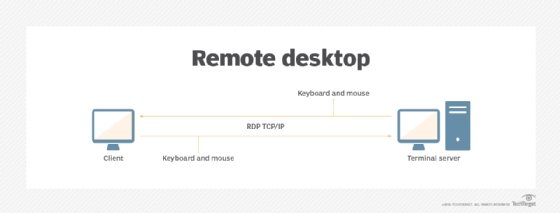remote desktop
What is a remote desktop?
A remote desktop is a program or an operating system feature that allows a user to connect to a computer in another location, see that computer's desktop and interact with it as if it were local.
How does a remote desktop work?
Remote desktop software captures a device's screen and mouse and keyboard inputs and transmits them to another device, where a user can view or control it remotely. Tech support professionals often use remote desktop connectivity to troubleshoot live fixes on a client's computer.
Many of these tools also allow file sharing with the remote computer -- or just the clipboard's content -- from the controlling machine to the remote machine and vice versa. A remote desktop can also allow access to audio in some cases, where the sound on the remote computer transmits to the controlling device.

Why do people use remote desktops?
People use remote desktop access capabilities to perform several tasks, including the following:
- access a workplace computer from home or when traveling;
- access a home computer from other locations;
- fix a computer problem;
- perform administrative tasks;
- demonstrate something, such as a process or a software application;
- perform file transfers from one machine to another; and
- print documents from the remote machine.
Benefits of remote desktops
IT pros and organizations see remote support as a valuable tool to improve security and provide end users the flexibility to use personal devices or low-cost endpoint devices to access key resources within the corporate network. Additional benefits include the following:
This article is part of
What is desktop management and how does it work?
- access restricted content located on remote networks from any endpoint;
- offer flexibility to work virtually anywhere while still able to access company network and content;
- reduce the cost of workstations by using server technology to deliver a full remote desktop to a low-cost thin client or machine; and
- restrict access to specific applications and systems to machines located within the network.
Challenges of remote desktops
There are a few ways to implement a remote desktop for an organization. In some cases, users can adopt free online tools to implement a remote desktop, while other alternatives are more enterprise-ready. These choices can pose a significant challenge for IT if users deploy remote desktop tools without prior approval or notification. Other challenges include the following:
- Using a remote desktop requires bandwidth, which means a company may see some performance issues and a lag in mouse movement and response time.
- Remote Desktop Protocol (RDP) does not do well with video playing on the remote machine as it must transition the frames or screens, which affects the video quality.
- Some remote desktop server tools can be costly.
- Not all remote desktop tools offer the same set of features, making it challenging for IT and users to know what tool would work best for their needs.
Remote desktop protocols
A remote desktop connection relies upon any of several protocols, including RDP, virtual network computing (VNC), NX, or NoMachine, technology and Independent Computing Architecture.
Remote desktop access software
Remote desktop access software exists for most operating systems and platforms, including hand-held computing devices. Microsoft and Apple each have a product called "Remote Desktop." Other remote desktop products include Citrix XenApp, CrossLoop, GoToMyPC, ConnectWise Control, TeamViewer and Chicken of the VNC.
Cloud remote desktop services
Another generation of remote desktop tools from Microsoft allows companies to use the Microsoft Azure cloud to connect directly to a virtual desktop in its cloud. Azure Virtual Desktop enables a company to give users access to a complete workstation hosted in the cloud using some of the traditional remote desktop tools. VMware and Citrix offer similar products that allow IT to deploy desktops or machines virtually and enable end users to remotely connect to them.








